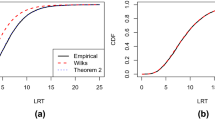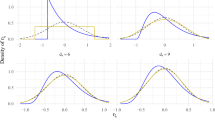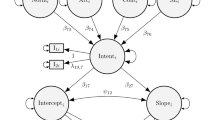Abstract
Data in social and behavioral sciences typically possess heavy tails. Structural equation modeling is commonly used in analyzing interrelations among variables of such data. Classical methods for structural equation modeling fit a proposed model to the sample covariance matrix, which can lead to very inefficient parameter estimates. By fitting a structural model to a robust covariance matrix for data with heavy tails, one generally gets more efficient parameter estimates. Because many robust procedures are available, we propose using the empirical efficiency of a set of invariant parameter estimates in identifying an optimal robust procedure. Within the class of elliptical distributions, analytical results show that the robust procedure leading to the most efficient parameter estimates also yields a most powerful test statistic. Examples illustrate the merit of the proposed procedure. The relevance of this procedure to data analysis in a broader context is noted.
Similar content being viewed by others
References
Arminger, G., Stein, P., & Wittenberg, J. (1999). Mixtures of conditional mean- and covariance structure models.Psychometrika, 64, 475–494.
Beran, R., & Srivastava, M.S. (1985). Bootstrap tests and confidence regions for functions of a covariance matrix.Annals of Statistics, 13, 95–115.
Bollen, K.A. (1989).Structural equations with latent variables. New York: Wiley.
Bollen, K.A., & Stine, R. (1993). Bootstrapping goodness of fit measures in structural equation models. In K.A. Bollen and J.S. Long (Eds.),Testing structural equation models. Newbury Park, CA: Sage.
Browne, M.W. (1984). Asymptotic distribution-free methods for the analysis of covariance structures.British Journal of Mathematical and Statistical Psychology, 37, 62–83.
Campbell, N.A. (1980). Robust procedures in multivariate analysis I: Robust covariance estimation.Applied Statistics, 29, 231–237.
Campbell, N.A. (1982). Robust procedures in multivariate analysis II: Robust canonical variate analysis.Applied Statistics, 31, 1–8.
Davison, A.C., & Hinkley, D.V. (1997).Bootstrap methods and their application. Cambridge: Cambridge University Press.
Devlin, S.J., Gnanadesikan, R., & Kettenring, J.R. (1981). Robust estimation of dispersion matrices and principal components.Journal of the American Statistical Association, 76, 354–362.
Donoho, D., & Huber, P.J. (1983). The notion of breakdown point. In P.J. Bickel, K.A. Doksum, and J.L. Hodges (Eds.),A Festschrift for Erich L. Lehmann (pp. 157–184). Belmont, CA: Wadsworth.
Efron, B. (1979). Bootstrap methods: Another look at the jackknife.Annals of Statistics, 7, 1–26.
Efron, B., & Tibshirani, R.J. (1993).An Introduction to the bootstrap. New York: Chapman & Hall.
Green, S.B., Thompson, M.S., & Poirier, J. (1999). Exploratory analysis to improve model fit: Errors due to misspecification and a strategy to reduce their occurrence.Structural Equation Modeling, 6, 113–26.
Hawkins, D.M., & Olive, D.J. (1999). Improved feasible solution algorithms for high breakdown estimation.Computational Statistics & Data Analysis, 30, 1–11.
Hampel, F.R. (1974). The influence curve and its role in robust estimation.Journal of the American Statistical Association, 69, 383–393.
Hampel, F.R., Ronchetti, E.M., Rousseeuw, P.J., & Stahel, W.A. (1986).Robust statistics: The approach based on influence functions. New York: Wiley.
Hu, F., & Hu, J. (2000). A note on breakdown theory for bootstrap methods.Statistics & Probability Letters, 50, 49–53.
Huber, P.J. (1977). Robust covariances. In S.S. Gupta and D.S. Moore (Eds.),Statistical Decision Theory and Related Topics, Vol. 2 (pp. 165–191). New York: Academic Press.
Kano, Y., Berkane, M., & Bentler, P.M. (1993). Statistical inference based on pseudo-maximum likelihood estimators in elliptical populations.Journal of the American Statistical Association, 88, 135–143.
Lehmann, E.L. (1983).Theory of point estimation. New York: Wiley.
Lopuhaä, H.P. (1989). On the relation between S-estimators and M-estimators of multivariate location and covariances.Annals of Statistics, 17, 1662–1683.
Magnus, J.R., & Neudecker, H. (1999).Matrix differential calculus with applications in statistics and econometrics. New York: Wiley.
Mardia, K.V. (1970). Measure of multivariate skewness and kurtosis with applications.Biometrika, 57, 519–530.
Maronna, R.A. (1976). Robust M-estimators of multivariate location and scatter.Annals of Statistics, 4, 51–67.
Marshall, L.L. (1999). Effect of men's subtle and overt psychological abuse on low income women.Violence and Victims, 14, 69–88.
Muirhead, R.J., & Waternaux, C.M. (1980). Asymptotic distributions in canonical correlation analysis and other multivariate procedures for nonnormal populations.Biometrika, 67 31–43.
Newcomb, M.D., & Bentler, P.M. (1988).Consequences of adolescent drug use: Impact on the lives of young adults. Beverly Hills: Sage Publications.
Rousseeuw, P.J., & van Zomeren, B.C. (1990). Unmasking multivariate outliers and leverage points (with discussion).Journal of the American Statistical Association, 85, 633–51.
Ruppert, D. (1992). Computing S estimators for regression and multivariate location/dispersion.Journal of Computational and Graphical Statistics, 1, 253–270.
Satorra, A., & Bentler, P.M. (1994). Corrections to test statistics and standard errors in covariance structure analysis. In A. von Eye and C.C. Clogg (Eds.),Latent variables analysis: Applications for developmental research (pp. 399–419). Thousand Oaks, CA: Sage.
Shapiro, A., & Browne, M.W. (1987). Analysis of covariance structure under elliptical distributions.Journal of the American Statistical Association, 82, 1092–1097.
Singh, K. (1998). Breakdown theory for bootstrap quantiles.Annals of Statistics, 26, 1719–1732.
Sörbom, D. (1989). Model modification.Psychometrika, 54, 371–84.
Stein, J.A., Newcomb, M.D., & Bentler, P.M. (1996). Initiation and maintenance of tobacco smoking: Changing personality correlates in adolescence and young adulthood.Journal of Applied Social Psychology, 26, 160–187.
Stromberg, A.J. (1997). Robust covariance estimates based on resampling.Journal of Statistical Planning and Inference, 57, 321–334.
Tyler, D.E. (1982). Radial estimates and the test for sphericity.Biometrika, 69, 429–436.
Tyler, D.E. (1983). Robustness and efficiency properties of scatter matrices.Biometrika, 70, 411–420.
Weston, R., Marshall, L., & Yuan, K.-H. (1999). Structural equation modeling of social exchange theory, violence and positive behaviors in the relationships of low income women. Paper presented at the joint conference ofThe International Network on Personal Relationships and the International Society for the Study of Personal Relationships. June, 1999. KY: University of Louisville.
Woodruff, D.L., & Rocke, D.M. (1994). Computable robust estimation of multivariate location and shape in high dimension using compound estimators.Journal of the American Statistical Association, 89, 888–896.
Yuan, K.-H., & Bentler, P.M. (1998a). Robust mean and covariance structure analysis.British Journal of Mathematical and Statistical Psychology, 51, 63–88.
Yuan, K.-H., & Bentler, P.M. (1998b). Structural equation modeling with robust covariances.Sociological Methodology, 28, 363–396.
Yuan, K.-H., & Bentler, P.M. (1999). On normal theory and associated test statistics in covariance structure analysis under two classes of nonnormal distributions.Statistical Sinica, 9, 831–853.
Yuan, K.-H., Chan, W., & Bentler, P.M. (2000). Robust transformation with applications to structural equation modeling.British Journal of Mathematical and Statistical Psychology, 53, 31–50.
Yuan, K.-H., & Hayashi, K. (2003). Standard errors with misspecified covariance structure models. Tentatively accepted byBritish Journal of Mathematical and Statistical Psychology.
Yuan, K.-H., Marshall, L.L., & Bentler, P.M. (2003). Assessing the effect of model misspecifications on parameter estimates in structural equation models.Sociological Methodology, 33, 241–265.
Yung, Y.F. (1997). Finite mixtures in confirmatory factor-analysis models.Psychometrika, 62, 297–330.
Yung, Y.-F., & Bentler, P.M. (1996). Bootstrapping techniques in analysis of mean and covariance structures. In G.A. Marcoulides and R.E. Schumacker (Eds.),Advanced structural equation modeling: Techniques and issues (pp. 195–226). Hillsdale, NJ: Lawrence Erlbaum.
Author information
Authors and Affiliations
Corresponding author
Additional information
The authors thank the editor, an associate editor and four referees for their constructive comments, which led to an improved version of the paper.
Rights and permissions
About this article
Cite this article
Yuan, KH., Bentler, P.M. & Chan, W. Structural equation modeling with heavy tailed distributions. Psychometrika 69, 421–436 (2004). https://doi.org/10.1007/BF02295644
Received:
Revised:
Issue Date:
DOI: https://doi.org/10.1007/BF02295644




